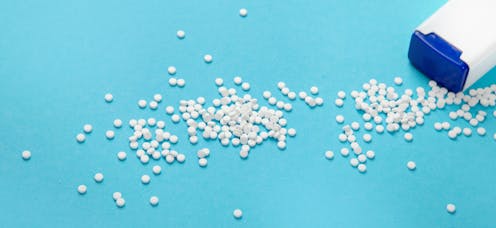
With so much health advice to avoid excessive sugar in our diets to reduce risks obesity and tooth decay, some people choose to use artificial sweeteners as an alternative in hot drinks and recipes.
Artificial sweeteners that mimic the composition of sugar can be made in the lab from carbon, hydrogen and oxygen. Some reports suggest that artificial sweeteners directly affect human gut health, but there is currently little evidence for this.
The fate of such sweeteners once they enter our environment is rarely considered. But a recent study from researchers at the University of Florida shows a commonly used artificial sweetener, sucralose, may have negative effects on our freshwater ecosystems.
This study measured the effect of sucralose (also known as E955), one of the sweeteners approved for use in the UK, on microbes in our water systems. Researchers found the presence of sucralose hindered the growth of blue-green algae (or cyanobacteria) which photosynthesise to produce oxygen, help regulate oxygen levels in the marine environment, and provide a food source for many organisms including fish.
Ingesting sucralose in place of these nutrients means the microbes do not grow, as sucralose cannot be broken down by the enzymes that degrade natural sugars to fuel their metabolism.
In turn, this may have adverse effects up the food chain and disrupt carefully balanced ecosystems once sucralose is released into our water system and the wider environment. A 2019 study found that the presence of sucralose can cause DNA damage and genetic mutations in freshwater fish such as carp.
Sweet yet persistent
Artificial sweeteners such as sucralose are not metabolised by the human body so they are excreted – this is what makes them low-calorie sugar alternatives. And that’s where the environmental problem begins. Current wastewater treatment plants are unable to remove these sugar mimics, meaning they end up in our environment – in our water, rivers and soil.
To compound this, sucralose is very hard to break down – it is a persistent pollutant, or “forever chemical”. This is because it does not easily undergo bacterial decomposition.
Forever chemicals are increasingly present in our streams, rivers and oceans – most notably per- and polyfluoroalkyl substances (PFAS) that don’t degrade. PFAS are synthetic chemicals found in many consumer products, including skincare products, cosmetics and waterproof clothing. PFAS can remain in the human body for many years, and some present significant risks to our health – potentially causing liver damage, thyroid disease, obesity, infertility and cancer.
Artificial sweeteners that persist in our environment act like PFAS because they cannot be broken down. If they cannot be completely avoided, then methods of adequately removing and recovering them from wastewater are urgently required.
These include the use of biomimetic membranes – filtration devices containing naturally occurring proteins that remove contaminants from water. Together with researchers around the world, we are developing new bioinspired membranes that mimic biological gateways found in nature. These will be able to selectively extract compounds from water at low pressure with low energy input.
As an example, cells need to take up phosphate to make DNA, but this cannot just cross the fatty membranes that surround all cells. Therefore, special transport proteins exist in the cell membranes, acting as specific “gates” to let phosphate into cells. Bioinspired membranes extract and embed these transport proteins in plastic membranes that can be used to commercially remove phosphate from water in a specific way.
Above all, this research should serve as a reminder that policymakers and water companies need to strive harder to minimise the many sources of chemical pollution that can affect water quality in the environment.
Matthew Derry consults to Aquaporin A/S. He receives funding from UKRI, Research England, EPSRC and the British Council.
Alan Goddard consults to Aquaporin A/S. He receives funding from Research England, EPSRC, BBSRC, the Royal Society and the EU.
This article was originally published on The Conversation. Read the original article.







